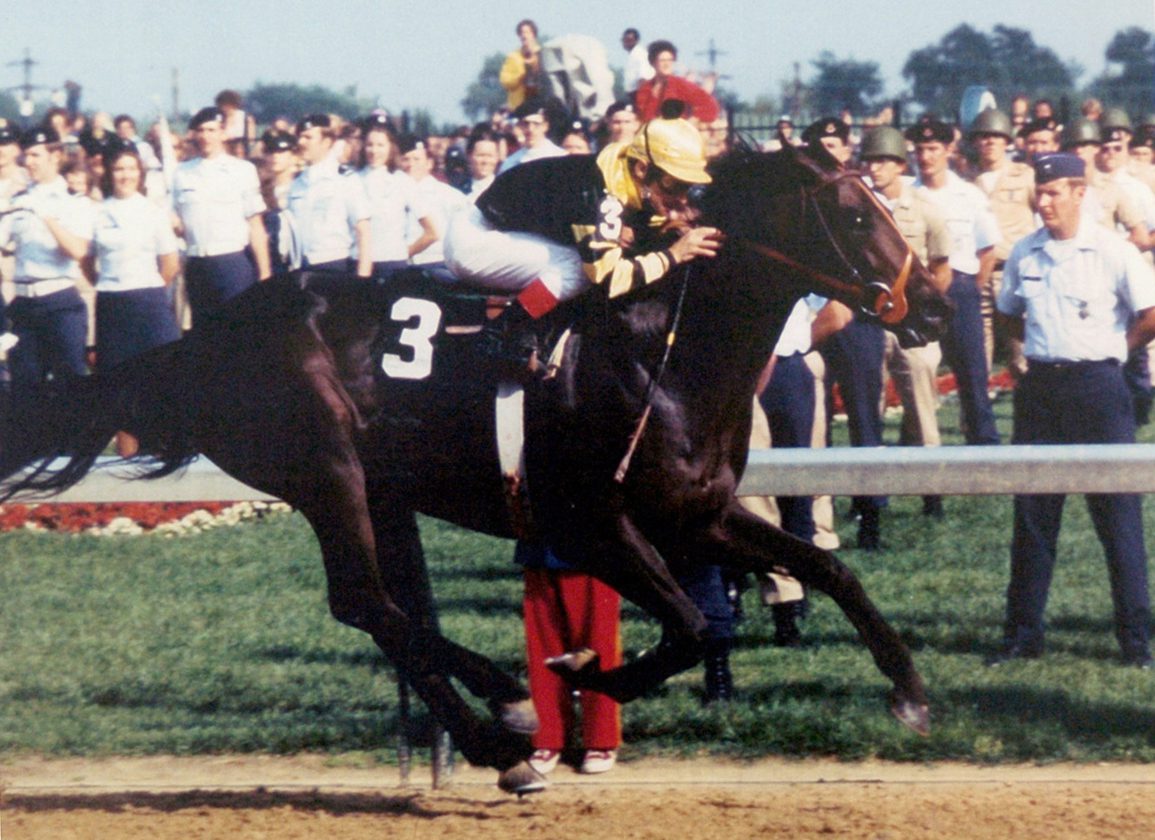By Jill Williams
In this continuing series, we examine the past winners of significant filly/mare races by the lasting influence they've had on the breed. Up today is the GI Spinaway S., currently the first Grade I of the year for 2-year-olds in the country.
Dating to 1881, back when the Kentucky Derby was running for just the seventh time, President James Garfield was assassinated in office, and there was what would become a legendary shootout at the O.K. Corral, the Spinaway has seen its share of history. The race itself is named after 1880's top 2-year-old filly, who beat colts seven times in stakes that year. She was by Leamington, who, among his spate of top progeny, also sired Aristides (winner of the inaugural Kentucky Derby) and Iroquois (the first U.S.-bred horse to win the Epsom Derby and St. Leger across the pond). Spinaway herself foaled a couple of nice runners and was granddam of 1904 Spinaway winner Tanya, remembered today for winning the 1905 Belmont S.
Contrary to more recent trends, the Spinaway S. has actually increased in distance from its beginnings. It started as a five-furlong contest, was bumped up to 5 1/2 furlongs in 1901, increased again to six panels in 1922, and has been run at seven-eighths since 1994. With the unprecedented Tapit filly deadheat in 2016 and a number of missed years early on, the Spinaway has officially recorded 131 individual winners. How they have fared as broodmares!
Some of the Spinaway winners who belong on this list were previously featured in our “Background Checks” for the GI Alabama S., GI Test S., or GIII Schuylerville S.; please see those earlier profiles for notes on Hot Dixie Chick, Meadow Star, Talking Picture, Numbered Account (who already appeared in two!), Moccasin, Risque, and Sallie McClelland. Following are the some of the other most important Spinaway winners by what impact they have had on the breed through their sons and daughters.
Alanesian (1954, Polynesian–Alablue, by Blue Larkspur): This E. Barry Ryan/Normandy Farm-bred mare produced three stakes winners, including Princessnesian, one of the handful of mares to win the Hollywood Gold Cup. A number of significant winners trace to her, including champion granddaughter Revidere, but the legacy she's left on the breed–through sons, grandsons, and the like–is absolutely staggering. Without her son Boldnesian, there would be no Seattle Slew. Without her grandson Ride the Rails, there would be no Candy Ride (Arg). And without her great-great grandson Harlan's Holiday, there would be no Into Mischief.
Sunday Evening (1947, Eight Thirty–Drowsy, by Royal Minstrel {GB}): She produced just one stakes winner–1964 Test winner Time for Bed–but this Greentree Stud homebred's daughters and descendants produced champion 2-year-old Silent Screen; champion 3-year-old filly Dark Mirage; multiple European champion Indian Skimmer; Irish champion Bluebird; GISWs Missy's Mirage, Classy Mirage, Java Gold, Swagger Jack, Timely Writer, and Timely Assertion; and many more.
Myrtle Charm (1946, Alsab–Crepe Myrtle, by Equipoise): One daughter won the Frizette and Alcibiades, but it was another daughter who produced My Charmer, dam of Horse of the Year and incredible breed-shaping sire Seattle Slew. A smattering of other nice horses appear in the family, including Seattle Slew's half-brother, G1 Two Thousand Guineas winner Lomond, but nothing else could compare to the accomplishments of the great Slew. Myrtle Charm was bred by Brownell Combs and Leslie Combs II.
Bellesoeur (1945, Beau Pere {GB}–Donatrice {GB}, by Donatello II {Fr}): Bred in California by Louis B. Mayer, co-founder of MGM Studios, this mare was extremely prolific, with nearly four dozen stakes winners produced by her and her daughters in just the first couple of generations alone. She remains relevant although distant in pedigrees today, as last year's ill-fated Medina Spirit traced directly to her, as did 2015 Canadian Horse of the Year Catch a Glimpse.
Our Page (1940, Blue Larkspur–Occult, by Dis Donc {Fr}): This Royce G. Martin homebred produced five foals, all colts. All were stakes winners and all were sires, the best of whom was undoubtedly Bull Page. He was Canadian Horse of the Year in 1951 and an influential Canadian sire. His most long-lasting effect on the breed is as broodmare sire of Nijinsky II and a son of his was the broodmare sire of Storm Bird. Our Page was named Broodmare of the Year in 1948 when Bull Page was just a yearling.
Now What (1937, Chance Play–That's That, by High Time): She produced Next Move, a dual champion in the U.S. and a 12-time stakes winner of races that are almost overwhelmingly designated as Grade I today. A number of other top horses trace to the Three D's Stock Farm-bred as well, but her pièce de résistance is surely great-great granddaughter Pasadoble, who singlehandedly founded a dynasty of champions. Pasadoble's greatest foal was her first: multiple French, English, and U.S. champion Miesque, who in turn produced champion East of the Moon, additional MG1SW Kingmambo, and two other GSWs. Other champions of the last two decades descended from Pasadoble include Alpha Centauri (Ire), Six Perfections (Fr), Rumplestiltskin (Ire), and Loves Only You (Jpn).
Blue Warbler (1922, North Star III {GB}–May Bird {GB}, by Thrush {GB}): It may be more of a challenge to find this mare of a century ago in pedigrees today, but it can still be done. Her handful of foals included champions Barn Swallow and Balladier. The latter was a good sire whose sons Double Jay and Spy Song can still be found buried in many a current runner.
Court Dress (1904, Disguise–Hampton Belle {GB}, by Hampton {GB}): Records start getting spotty this far back, but there's no doubt this mare has a vast number of top-class horses tracing to her, including leading sires Deputy Minister and Exclusive Native.
Not a subscriber? Click here to sign up for the daily PDF or alerts.







